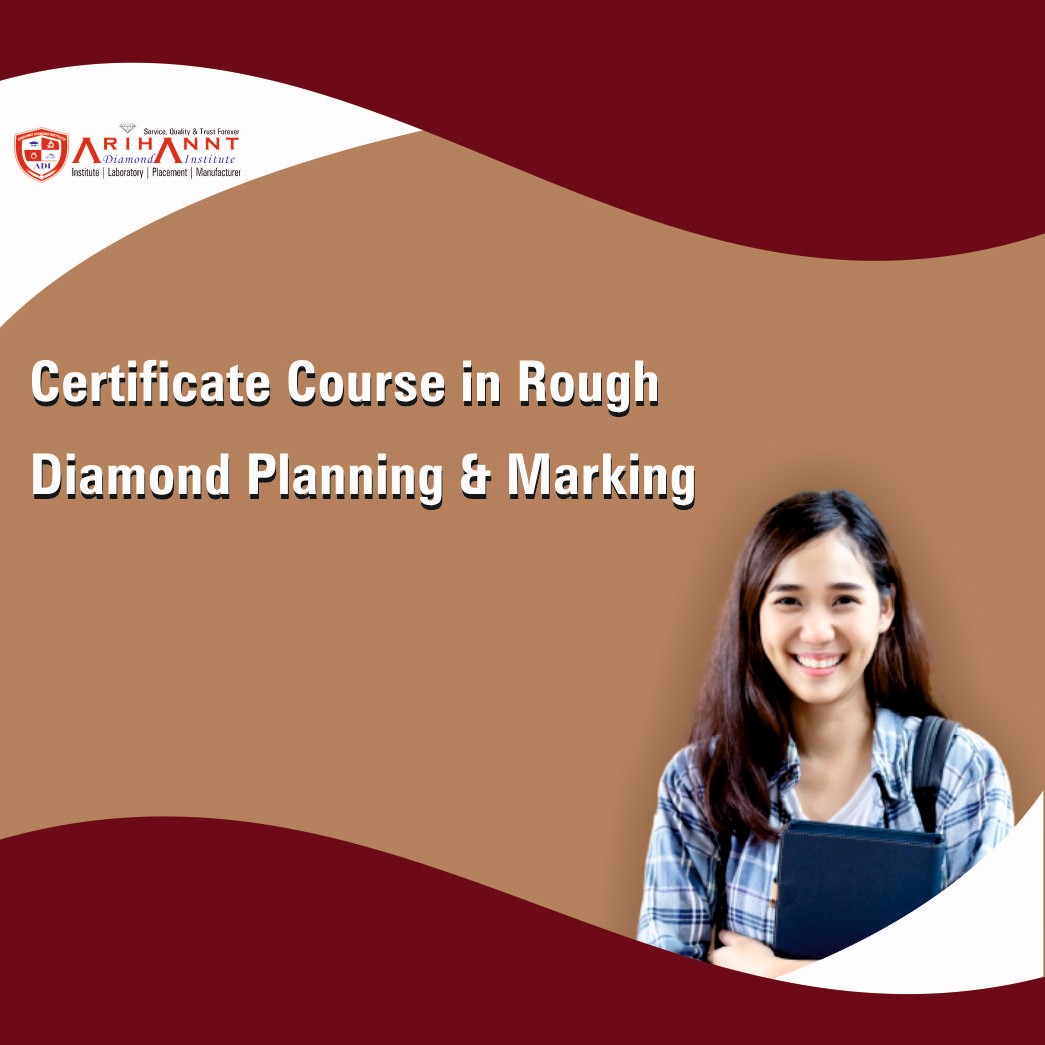In this article, here we want to give information about the "Certificate Course In Rough Diamond Planning & Marking" In this course Student be able to do International Defects Knowledge, Rough Assortment, Rough Diamond knowledge with Valuation (Theorical), And Also Deeply Students get knowledge about Rough Diamond Planning & Marking.
Welcome to Arihant Diamond Institute, we are here for the "Certificate Course in Rough Diamond Panning and Marking." Course about Planning & Marking in Rough Diamond.Rough diamonds are also often referred to as uncut diamonds, raw diamonds or natural diamonds.Rough Diamonds are more real than polished diamonds! Because they are exactly as nature intended them to be in their raw form.
Rough Diamond Classifications
- Diamonds for Cleavage
- Diamonds for Sawing
- Diamonds for Cutting
- Industrial Diamonds
Diamond rough's quality the equivalent of polished goods' clarity – is the next aspect for evaluation. Inclusions and their reflections, as well as areas of stress and strain, must be considered.
The statement Rough means Raw Diamond which has not yet been cut. Normally, the word Sorting is applied to rough diamonds. The assorted needs to have more intimate knowledge of diamonds.
Rough Diamond Planning & Marking Process
Planning is the process of deciding how to cut and polish a diamond to maximise its value. In today’s manufacturing environment,
planners use a combination of their skills and technology.
1. The planning stage includes:
· Creating a 3D surface model of the rough diamond (not used for small diamonds due to cost)
· Plotting clarity features
· Planning the cutting and polishing to maximise yield
· Pre-process sorting
Once the plan has been chosen, if the stone needs to be cut it will be marked by pen or automated laser marking to show the
cleaver/sawyer where the cut should be made. It is during this planning stage that the decision on whether to saw, cleave or polish the diamond will be made.
2. 3A – CLEAVING
Many diamonds require dividing into more than one part to get the best overall yield and/or clarity. One process used to divide a diamond is cleaving, which is often performed on stones where the structure has internal cracks and fractures so a better overall clarity can be achieved with its removal or avoidance.
The cleaving process involves:
Kerfing the stone - the creation of a notch or groove that will enable the cleaving. This can be completed manually using another diamond, or by laser.
Cleaving the stone into two or more parts between the crystallized layers along the lines of its growth is completed using a sharp blade. This will remove the heavily included area of the diamond.
Laser kerfing is highly accurate, allowing precise control of the location, direction, width and depth of the kerf and even the removal of small pieces of diamond. Diamond cleavers need extensive knowledge of the structure and qualities of diamonds.
Cleaving is preferable to sawing wherever possible since it involves less wastage. Diamond cleavers need exceptional skills and in-depth knowledge of the structure and properties of diamonds. They must understand the inherent potential of every individual stone. Their familiarity with the different types of rough stones enables them to maximize the potential of every gem, especially those with a complex or heavily included structure.
3. 3B – LASER SAWING
‘Laser’ stands for ‘light amplification by the stimulated emissions of radiation’.It has revolutionised the diamond cutting industry, offering savings in time and money. It enables the cutting of material that would have been unworkable previously, and can greatly reduce the risk of damage. It also allows an almost limitless assortment of fancy shapes, as you are not restricted by the crystal structure of the diamond. The reason you are not restricted in that the laser burns the crystal structure.
Once the stone has been laser sawn, it looks blackish and opaque. Cleaning procedures return it to its original appearance.
4. 3C – SAWING
Blade sawing can only be carried out on a diamond in certain directions which are different from the cleavage directions. Before any sewing takes place the stone is marked with a line where the blade will divide the stone.
The sawing machine consists of a metal frame that has a weighted arm mounted from the back. The diamond is held in a clamping arm that is mounted on the arm above the saw blade. At the bottom of the arm, there is a counterweight which controls the lowering of the diamond onto the saw blade allowing the sawing action to take place. The sawyer can be responsible for multiple machines and is in charge of changing the pressure of the weight and applying sawing powder to the blades. It takes almost an hour to an hour and a half to see 1ct. of dia amond.During blade sawing, weight loss of approximately 2% is expected.
So this course duration will be 170days complete package of in Rough Diamond and we teach the students can able to do Planning & Marking in Rough Diamond.The Certificate process will be students giving the exam will be a practical and theoretical exam on completion of the course after that they will get a certificate. Also, Institute gives full getting a job in this field.

